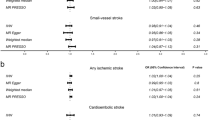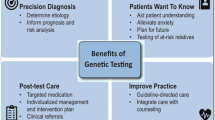Abstract
Recently, the association of polymorphism rs1800562 (p.C282Y) in the hemochromatosis (HFE) gene with the increased risk of venous ulceration was shown. We hypothesized that HFE gene polymorphism might be involved not only in ulceration process, but also in susceptibility to primary varicose veins. We genotyped HFE p.C282Y (rs1800562) and p.H63D (rs1799945) variants in patients with primary varicose veins (n = 463) and in the control group (n = 754). In our study, p.282Y variant (rs1800562 A allele) was significantly associated with the risk of varicose veins (OR 1.79, 95 % CI = 1.11–2.89, P = 0.02). A borderline significant reverse association of p.63D variant (rs1799945 G allele) with venous leg ulcer development was revealed in Russians (OR 0.25, 95 % CI = 0.06–1.00, P = 0.05), but not in the meta-analysis (P = 0.56). We conclude that the HFE gene polymorphism can affect the risk of developing primary varicose veins.

Similar content being viewed by others
References
Maurins U, Hoffmann BH, Lösch C, et al. Distribution and prevalence of reflux in the superficial and deep venous system in the general population–results from the Bonn Vein Study, Germany. J Vasc Surg. 2008;48:680–7. doi:10.1016/j.jvs.2008.04.029.
Abramson JH, Hopp C, Epstein LM. The epidemiology of varicose veins. A survey in western Jerusalem. J Epidemiol Community Health. 1981;35:213–7.
Fowkes FG, Evans CJ, Lee AJ. Prevalence and risk factors of chronic venous insufficiency. Angiology. 2001;52(Suppl 1):S5–15.
Ruckley CV, Evans CJ, Allan PL, et al. Chronic venous insufficiency: clinical and duplex correlations. The Edinburgh Vein Study of venous disorders in the general population. J Vasc Surg. 2002;36:520–5.
Savel’ev VS, Kirienko AI, Zolotukhin IA,SeliverstovEI (2012) Prospektivnoe observatsionnoe issledovanie SPEKTR: registr patsientov c khronicheskimi zabolevaniyami ven nizhnikh konechnostey (The prospective observational study SPEKTR: the registry of the patients presenting with chronic venous diseases of the lower). Flebologiya 6: 4–9.
Arnoldi CC. The heredity of venous insufficiency. Dan Med Bull. 1958;5:169–76.
Mayall RC. Varicose disease considered as hereditary clinical disease. Resen Clin Cient. 1968;37:28–9.
Chatard H. Should the topography of hereditary varices be considered from the genetic angle? Phlebologie. 1968;21(3):303.
Gundersen J, Hauge M. Hereditary factors in venous insufficiency. Angiology. 1969;20:346–55.
Cornu-Thenard A, Boivin P, Baud JM, et al. Importance of the familial factor in varicose disease. Clinical study of 134 families. J Dermatol Surg Oncol. 1994;20:318–26.
Pistorius MA. Chronic venous insufficiency: the genetic influence. Angiology. 2003;54(Suppl 1):S5–12.
Coon WW. Willis PW3rd, Keller JB. Venous thromboembolism and other venous disease in the Tecumseh community health study. Circulation. 1973;48:839–46.
Guberan E, Widmer LK, Glaus L, et al. Causative factors of varicose veins: myths and facts. An epidemiological study of 610 women. Vasa. 1973;2:115–20.
Da Silva A, Widmer LK, Martin H, et al. Varicose veins and chronic venous insufficiency. Vasa. 1974;3:118–25.
Brand FN, Dannenberg AL, Abbott RD, Kannel WB. The epidemiology of varicose veins: the Framingham Study. Am J Prev Med. 1988;4:96–101.
Nelzen O, Bergqvist D, Lindhagen A. The prevalence of chronic lower-limb ulceration has been underestimated: results of a validated population questionnaire. Br J Surg. 1996;83:255–8.
Jin Y, Xu G, Huang J, et al. Analysis of the association between an insertion/deletion polymorphism within the 3′ untranslated region of COL1A2 and chronic venous insufficiency. Ann Vasc Surg. 2013;27:959–63. doi:10.1016/j.avsg.2013.04.001.
Görmüş U, Kahraman ÖT, İsbir S, et al. MMP2 gene polymorphisms and MMP2 mRNA levels in patients with superficial varices of lower extremities. Vivo. 2011;25(3):387–91.
Katrancioglu N, Manduz S, Ozen F, et al. Type I plasminogen activator inhibitor 4G allele frequency is associated with chronic venous insufficiency. J Int Med Res. 2010;38:1513–8.
Sverdlova AM, Bubnova NA, Baranovskaya SS, et al. Prevalence of the methylenetetrahydrofolate reductase (MTHFR) C677T mutation in patients with varicose veins of lower limbs. Mol Genet Metab. 1998;63:35–6.
Xu H, Zhao Y, Zhang X, et al. Polymorphisms in MMP-9 and TIMP-2 in Chinese patients with varicose veins. J Surg Res. 2011;168:e143–8. doi:10.1016/j.jss.2010.11.002.
Nagy N, Szolnoky G, Szabad G, et al. Single nucleotide polymorphisms of the fibroblast growth factor receptor 2 gene in patients with chronic venous insufficiency with leg ulcer. J Invest Dermatol. 2005;124:1085–8.
Hafner J, Kühne A, Schär B, et al. Factor V Leiden mutation in postthrombotic and non-postthrombotic venous ulcers. Arch Dermatol. 2001;137:599–603.
Gaber Y, Siemens HJ, Schmeller W. Resistance to activated protein C due to factor V Leiden mutation: high prevalence in patients with post-thrombotic leg ulcers. Br J Dermatol. 2001;144:546–8.
Maessen-Visch MB, Hamulyak K, Tazelaar DJ, et al. The prevalence of factor V Leiden mutation in patients with leg ulcers and venous insufficiency. Arch Dermatol. 1999;135:41–4.
Peus D, Heit JA, Pittelkow MR. Activated protein C resistance caused by factor V gene mutation: common coagulation defect in chronic venous leg ulcers? J Am Acad Dermatol. 1997;36:616–20.
Tan JH, Price P, Gut I, et al. Characterization of tumor necrosis factor-α block haplotypes associated with susceptibility to chronic venous leg ulcers in Caucasian patients. Hum Immunol. 2010;71:1214–9. doi:10.1016/j.humimm.2010.09.001.
Gemmati D, Federici F, Catozzi L, et al. DNA-array of gene variants in venous leg ulcers: detection of prognostic indicators. J Vasc Surg. 2009;50:1444–51. doi:10.1016/j.jvs.2009.07.103.
Zamboni P, Tognazzo S, Izzo M, et al. Hemochromatosis C282Y gene mutation increases the risk of venous leg ulceration. J Vasc Surg. 2005;42:309–14.
Yeoh-Ellerton S, Stacey M. Iron and 8-Isoprostane levels in acute and chronic wounds. J Invest Dermatol. 2003;121(4):918–25.
Brissot P, Ropert M, Le Lan C, Loréal O. Non-transferrin bound iron: a key role in iron overload and iron toxicity. Biochim Biophys Acta. 2012;1820:403–10. doi:10.1016/j.bbagen.2011.07.014.
Kartikasari AE, Georgiou NA, Visseren FLJ, et al. Endothelial activation and induction of monocyte adhesion by nontransferrin-bound iron present in human sera. FASEB J. 2006;20:353–5.
Eklöf B, Rutherford RB, Bergan JJ, et al. Revision of the CEAP classification for chronic venous disorders: consensus statement. J Vasc Surg. 2004;40(6):1248–52.
Kirienko AI, Bogachev VIu, Gavrilov SG, et al. Chronic diseases of lower extremity veins in industrial workers of Moscow (results of the epidemiological survey). Angiol Sosud Khir. 2004;10(1):77–85.
Saveliev VS, Kirienko AI, Zolotukhin IA, Seliverstov EI. Prospective observational study SPECTRUM: the registry of patients with chronic venous diseases. Flebologia. 2012;6(1):4–9.
Abbade LP, Lastória S. Venous ulcer: epidemiology, physiopathology, diagnosis and treatment. Int J Dermatol. 2005;44:449–56.
Zamboni P, Izzo M, Tognazzo S, et al. The overlapping of local iron overload and HFE mutation in venous leg ulcer pathogenesis. Free Radic Biol Med. 2006;40:1869–73.
Robertson L, Lee AJ, Gallagher K, et al. Risk factors for chronic ulceration in patients with varicose veins: a case control study. J Vasc Surg. 2009;49:1490–8. doi:10.1016/j.jvs.2009.02.237.
Milic DJ, Zivic SS, Bogdanovic DC, et al. Risk factors related to the failure of venous leg ulcers to heal with compression treatment. J Vasc Surg. 2009;49:1242–7. doi:10.1016/j.jvs.2008.11.069.
Kuo KL, Hung SC, Lee TS, Tarng DC. Iron sucrose accelerates early atherogenesis by increasing superoxide production and upregulating adhesion molecules in CKD. J Am Soc Nephrol. 2014;25:2596–606. doi:10.1681/ASN.2013080838.
Schulz R, Murzabekova G, Egemnazarov B, et al. Arterial hypertension in a murine model of sleep apnea: role of NADPH oxidase 2. J Hypertens. 2014;32:300–5. doi:10.1097/HJH.0000000000000016.
Hirata Y, Yamamoto E, Tokitsu T, et al. Reactive oxygen metabolites are closely associated with the diagnosis and prognosis of coronary artery disease. J Am Heart Assoc. 2015;. doi:10.1161/JAHA.114.001451.
Prasad K, Dhar I. Oxidative stress as a mechanism of added sugar-induced cardiovascular disease. Int J Angiol. 2014;23:217–26. doi:10.1055/s-0034-1387169.
Budzyń M, Iskra M, Krasiński Z, et al. Serum iron concentration and plasma oxidant-antioxidant balance in patients with chronic venous insufficency. Med Sci Monit. 2011;17(12):CR719–27.
Zamboni P, Scapoli G, Lanzara V, et al. (2005) Serum iron and matrix metalloproteinase-9 variations in limbs affected by chronic venous disease and venous leg ulcers. Dermatol Surg. 31:644–9, discussion 649.
Ackerman Z, Seidenbaum M, Loewenthal E, Rubinow A. Overload of iron in the skin of patients with varicose ulcers. Possible contributing role of iron accumulation in progression of the disease. Arch Dermatol. 1988;124:1376–8.
Morrison HI, Semenciw RM, Mao Y, Wigle DT. Serum iron and risk of fatal acute myocardial infarction. Epidemiology. 1994;5:243–6.
De Valk B, Marx JJ. Iron, atherosclerosis, and ischemic heart disease. Arch Intern Med. 1999;159:1542–8.
Basuli D, Stevens RG, Torti FM, Torti SV. Epidemiological associations between iron and cardiovascular disease and diabetes. Front Pharmacol. 2014;5:117. doi:10.3389/fphar.2014.00117.
Feder JN, Gnirke A, Thomas W, et al. A novel MHC class I-like gene is mutated in patients with hereditary haemochromatosis. Nat Genet. 1996;13:399–408.
Acknowledgments
This work was supported by Russian Science Fund [Project 14-15-00734 « Searching of genes involved in varicose vein disease pathology »].
Author information
Authors and Affiliations
Corresponding author
Ethics declarations
Conflict of interest
The authors declare that there is no conflict of interest.
Ethical approval
All procedures performed in studies involving human participants were in accordance with the ethical standards of the institutional and/or national research committee and with the 1964 Helsinki Declaration and its later amendments or comparable ethical standards.
Additional information
Ekaterina A. Sokolova and Alexandra S. Shadrina have contributed equally to this work.
Rights and permissions
About this article
Cite this article
Sokolova, E.A., Shadrina, A.S., Sevost’ianova, K.S. et al. HFE p.C282Y gene variant is associated with varicose veins in Russian population. Clin Exp Med 16, 463–470 (2016). https://doi.org/10.1007/s10238-015-0377-y
Received:
Accepted:
Published:
Issue Date:
DOI: https://doi.org/10.1007/s10238-015-0377-y




